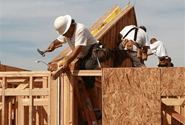Steel Markets

Housing Starts and Permit Authorizations Tumble in February
Written by Sandy Williams
March 17, 2021
Housing starts tumbled to a six-month low in February to a seasonally adjusted annual rate of 1.421 million, according to the U.S. Department of Housing and Urban Development and the U.S. Census Bureau. Starts were 10.3% below January’s rate and down 9.3% from February 2020. Part of the decline was due to the unusual winter weather across Texas and the South that stalled construction and supply chains.
Single-family home starts dropped 8.5% from January to February to a SAAR of 1.04 million. Multifamily housing of five units or more plunged 14.6% month-over-month. Despite falling numbers for February, single-family starts are trending upward from a year ago.
“While single-family starts for the first two months of the year are 6.4% higher than the first two months of 2020, there has been a 36% gain over the last 12 months of single-family homes permitted but not started, as some projects have paused due to cost and availability of materials,” said Robert Dietz, chief economist at the National Association of Home Builders.
Permit authorization for new homes fell 10.8% to a 1.68 million annualized rate in February. Single-family permits were down 10.0% and multifamily permits 12.5%.
“Despite strength in buyer traffic and lack of existing inventory, builders are slowing some production of single-family homes as lumber and other material costs, along with interest rates, continue to rise,” said Chuck Fowke, NAHB chairman. “Shortages of lumber and other building materials, including appliances, are putting future construction expansion at risk.”
Soaring lumber prices have added approximately $24,000 to the price of a new home, said Dietz.
The NAHB/Wells Fargo Housing Market Index (HMI), released this week, shows builder confidence wavering slightly for newly built-single family homes, falling two points to 82 in March. “Builder confidence peaked at a level of 90 last November and has trended lower as supply-side and demand-side factors have trimmed housing affordability,” said Dietz.
The HMI index for current sales expectations fell three points to 87, while future sales expectations in the next six months increased three points to 83. Existing-home inventory remains tight, which should benefit the new construction market.

Sandy Williams
Read more from Sandy WilliamsLatest in Steel Markets

Hot-rolled coil buyers continue seeking certainty
Steel market participants contend that buyers will remain in “wait-and-see" mode until some market stability is restored.

Latin American steel advocates warn on cheap import flood
Subsidized Chinese steel imports and cheap steel products from Association of Southeast Asian Nations (ASEAN) entering Latin American (LATAM) are threatening the region's steel market.

CRU: Steel prices fall amid global demand weakness
The forceful headwinds bearing down on steel markets across the globe have created demand challenges and sent prices southward. The US, however, challenged the global trend.

Hot-rolled price hikes garner mixed reactions from the market
Several steel market sources say they were blindsided when mills increased spot prices for hot-rolled coils this week.

Steel market participants mull the impact of US/Mexico S232 negotiations
Steel market participants learned that negotiations between the US and Mexico include discussions about Section 232 tariffs on steel and aluminum despite President Trump’s June 3 proclamation increasing the tariffs from 25% to 50% for all steel and aluminum imports—except for those from the UK.
